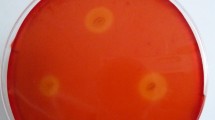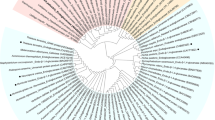Abstract
A novel endoglucanase gene was cloned from Rhizopus stolonifer and expressed in Escherichia coli, the gene product EG II (45 kDa) was assigned to Glycoside Hydrolase Family 45 (GH45), and its specific activity on phosphoric acid-swollen cellulose (PASC) was 48 IU/mg. To solve the problem of substrate accumulation in the cellulose hydrolysis and enhance the catalytic efficiency of endoglucanase, the eg2 gene was modified by site directed mutagenesis. Mutations generated by overlapping PCR have been proven to increase its catalytic activity on carboxymenthyl cellulose, microcrystalline cellulose (Avicel) and PASC, among which the mutant EG II-E containing all 6 mutations (N39S, V136D, T251G, D255G, P256S and E260D) peaked 121 IU/mg on PASC. The bioinformatic analysis showed that 2 key catalytic residues (D136 and D260) moved closer with the opening of a loop after mutagenesis, and a tunnel was formed by structural transformation. This structure was conducive for the substrate to access the active centre, and D136 played an indispensable role in the substrate recognition.






Similar content being viewed by others
References
Azevedo H, Bishop D, Cavaco-Paulo A (2000) Effects of agitation level on the adsorption, desorption, and activities on cotton fabrics of full length and core domains of EGV (Humicola insolens) and CenA (Cellulomonas fimi). Enzyme Microb Technol 27:325–329
Batista PR, de Souza Costa MG, Pascutti PG, Bisch PM, de Souza W (2011) High temperatures enhance cooperative motions between CBM and catalytic domains of a thermostable cellulase: mechanism insights from essential dynamics. Phys Chem Chem Phys 13:13709–13720
Béguin P, Aubert JP (1994) The biological degradation of cellulose. FEMS Microbiol Rev 13:25–58
Bhat MK (2000) Cellulases and related enzymes in biotechnology. Biotechnol Adv 18:355–383
Brooks BR, Bruccoleri RE, Olafson BD, States DJ, Swaminathan S, Karplus M (1983) CHARMM: a program for macromolecular energy, minimization, and dynamics calculations. J Comput Chem 4:187–217
Cantarel BL, Coutinho PM, Rancurel C, Bernard T, Lombard V, Henrissat B (2009) The carbohydrate-active enzymes database (CAZy): an expert resource for glycogenomics. Nucleic Acids Res 37:D233–D238
Carrard G, Koivula A, Söderlund H, Béguin P (2000) Cellulose-binding domains promote hydrolysis of different sites on crystalline cellulose. Proc Natl Acad Sci USA 97:10342–10347
Damude HG, Withers SG, Kilburn DG, Miller RC Jr, Warren RA (1995) Site-directed mutation of the putative catalytic residues of endoglucanase CenA from Cellulomonas fimi. Biochemistry 34:2220–2224
Davies G, Henrissat B (1995) Structures and mechanisms of glycosyl hydrolases. Structure 3:853–859
du Plessis L, Rose SH, van Zyl WH (2010) Exploring improved endoglucanase expression in Saccharomyces cerevisiae strains. Appl Microbiol Biotechnol 86:1503–1511
Elgavish S, Shaanan B (1997) Lectin-carbohydrate interactions: different folds, common recognition principles. Trends Biochem Sci 22:462–467
Franken KL, Hiemstra HS, van Meijgaarden KE, Subronto Y, den Hartigh J, Ottenhoff TH, Drijfhout JW (2000) Purification of his-tagged protein by immobilized chelate affinity chromatography: the benefits from the use of organic solvent. Protein Expr Purif 18:95–99
Ho SN, Hunt HD, Horton RM, Pullen JK, Pease LR (1989) Site-directed mutagenesis by overlap extension using the polymerase chain resction. Gene 77:51–59
Igarashi K, Ishida T, Hori C, Samejima M (2008) Characterization of an endoglucanase belonging to a new subfamily of glycoside hydrolase family 45 of the basidiomycete Phanerochaete chrysosporium. Appl Environ Microbiol 74:5628–5634
Irwin D, Shin D, Zhang S, Barr BK, Sakon J, Karplus A, Wilson DB (1998) Roles of the catalytic domain and two cellulose binding domains of Thermomonospora fusca E4 in cellulose hydrolysis. J Bacteriol 180:1709–1714
Kraulis PJ, Clore GM, Nilges M, Jones TA, Pettersson G, Knowles J, Gronenborn AM (1989) Determination of the three-dimensional solution structure of the C-terminal domain of cellobiohydrolase I from Trichoderma reesi. A study using nuclear magnetic resonance and hybrid distance geometry-dynamical simulated annealing. Biochemistry 28:7241–7257
Linder M, Nevanen T, Teeri TT (1999) Design of a pH-dependent cellulose-binding domain. FEBS Lett 447:13–16
Liu G, Wei X, Qin Y, Qu Y (2010) Characterization of the endoglucanase and glucomannanase activities of a glycoside hydrolase family 45 protein from Penicillium decumbens 114-2. J Gen Appl Microbiol 56:223–229
Medve J, Lee D, Tjerneld F (1998) Ion-exchange chromatographic purification and quantitative analysis of Trichoderma reesei cellulases cellobiohydrolase I, II and endoglucanase II by fast protein liquid chromatography. J Chromatogr A 808:153–165
Miettinen-Oinonen A, Londesborough J, Joutsjoki V, Lantto R, Vehmaanperä J, Biotecd PL (2004) Three cellulases from Melanocarpus albomyces for textile treatment at neutral pH. Enzyme Microb Technol 34:332–341
Miller GL, Blum R, Glennon WE, Burton AL (1960) Measurement of carboxymethylcellulase activity. Anal Biochem 1:127–132
Moriya T, Murashima K, Nakane A, Yanai K, Sumida N, Koga J, Murakami T, Kono T (2003) Molecular Cloning of Endo-beta-D-1,4-Glucanase Genes, rce1, rce2 and rce3, from Rhizopus oryzae. J Bacteriol 185:1749–1756
Nakazawa H, Okada K, Onodera T, Oqasawara W, Okada H, Morikawa Y (2009) Directed evolution of endoglucanase III (Cel12A) from Trichoderma reesei. Appl Microbiol Biotechnol 83:649–657
Ramos LP, Breuil C, Saddler JN (1993) The use of enzyme recycling and the influence of sugar accumulation on cellulose hydrolysis by Trichoderma cellulases. Enzyme Microb Tech 15:19–25
Sayle RA, Milner-White EJ (1995) Rasmol: biomolecular graphics for all. Trends Biochem Sci 20:374
Schou C, Rasmussen G, Kaltoft MB, Henrissat B, Schülein M (1993) Sterochemistry, specificity and kinetics of the hydrolysis of reduced cellodextrins by nine cellulases. Eur J Biochem 217:947–953
Schülein M (2000) Protein engineering of cellulases. Biochim Biophys Acta 1543:239–252
Shi H, Yin X, Wu M, Tang C, Zhang H, Li J (2012) Cloning and bioinformatics analysis of an endoglucanase gene (Aucel12A) from Aspergillus usamii and its functional expression in Pichia pastoris. J Ind Microbiol Biotechnol 39:347–357
Shimonaka A, Koga J, Baba Y, Nishimura T, Murashima K, Kubota H, Kono T (2006) Specific characteristics of family 45 endoglucanases from Mucorales in the use of textiles and laundry. Biosci Biotechnol Biochem 70:1013–1016
Teather RM, Wood PJ (1982) Use of congo red-polysaccharide interactions in enumeration and characterization of cellulolytic bacteria from the bovine rumen. Appl Environ Microbiol 43:4777–4780
Tomme P, Warren RAJ, Gilkes NR (1995) Cellulose hydrolysis by bacteria and fungi. Adv Microb Physiol 37:1–81
Valjakka J, Rouvinen J (2003) Structure of 20 K endoglucanase from Melanocarpus albomyces at 1.8 A resolution. Acta Crystallogr D Biol Crystallogr 59:765–768
Vlasenko E, Schülein M, Cherry J, Xu F (2010) Substrate specificity of family 5, 6, 7, 9, 12, and 45 endoglucanases. Bioresour Technol 101:2405–2411
Wang T, Liu X, Yu Q, Zhang X, Qu Y, Gao P, Wang T (2005) Directed evolution for engineering pH profile of endoglucanaseIII from Trichoderma reesei. Biomol Eng 22:89–94
Warner CD, Camci-Unal G, Pohl NLB, Ford C, Reilly PJ (2013) Substrate binding by the catalytic domain and carbohydrate binding module of ruminococcus flavefaciens FD-1 xyloglucanase/endoglucanase. Ind Eng Chem Res 52:30–36
Acknowledgments
This work was financially supported by the National Natural Science Foundation of China (No. 30270135).
Author information
Authors and Affiliations
Corresponding author
Rights and permissions
About this article
Cite this article
Tang, B., Zhang, Y., Yang, Y. et al. Expression and functional analysis of a glycoside hydrolase family 45 endoglucanase from Rhizopus stolonifer . World J Microbiol Biotechnol 30, 2943–2952 (2014). https://doi.org/10.1007/s11274-014-1722-0
Received:
Accepted:
Published:
Issue Date:
DOI: https://doi.org/10.1007/s11274-014-1722-0




